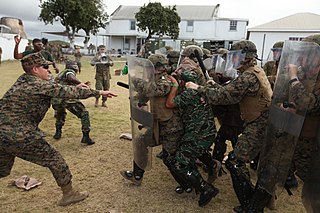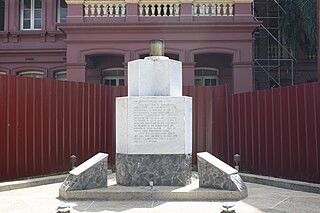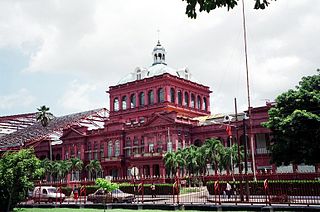Related Research Articles
The history of Trinidad and Tobago begins with the settlements of the islands by Indigenous First Peoples. Trinidad was visited by Christopher Columbus on his third voyage in 1498,, and claimed in the name of Spain. Trinidad was administered by Spanish hands until 1797, but it was largely settled by French colonists. Tobago changed hands between the British, French, Dutch, and Courlanders, but eventually ended up in British hands following the second Treaty of Paris (1814). In 1889, the two islands were incorporated into a single political entity. Trinidad and Tobago obtained its independence from the British Empire in 1962 and became a republic in 1976.

Port of Spain, officially the City of Port of Spain, is the capital of Trinidad and Tobago and the third largest municipality, after Chaguanas and San Fernando. The city has a municipal population of 49,867 (2017), an urban population of 81,142 and a transient daily population of 250,000. It is located on the Gulf of Paria, on the northwest coast of the island of Trinidad and is part of a larger conurbation stretching from Chaguaramas in the west to Arima in the east with an estimated population of 600,000.

A state of emergency is a situation in which a government is empowered to put through policies that it would normally not be permitted to do, for the safety and protection of its citizens. A government can declare such a state before, during, or after a natural disaster, civil unrest, armed conflict, medical pandemic or epidemic or other biosecurity risk.

Riot control measures are used by law enforcement, military, paramilitary or security forces to control, disperse, and arrest people who are involved in a riot, unlawful demonstration or unlawful protest.

Eric Williams Plaza, also known as the Eric Williams Financial Complex, located on Independence Square, Port of Spain, consists of two of the tallest buildings in Trinidad and Tobago, as well as in the English-speaking Caribbean. It consists of a pair of skyscrapers 22 stories high and 302 ft tall, locally known as the "Twin Towers". Construction on the complex started in 1979 and ended in 1986. The complex was officially opened on March 29, 1986. The architect who managed the construction was Anthony C. Lewis Partnership.

Arthur Napoleon Raymond Robinson, was a Trinidadian politician who was the third president of the country, serving from 19 March 1997 to 17 March 2003. He was also Trinidad and Tobago's third prime minister, serving in that capacity from 18 December 1986 to 17 December 1991. He is recognized for his proposal that eventually led to the founding of the International Criminal Court.

The Borough of Chaguanas is the largest municipality and fastest-growing town in Trinidad and Tobago. Located in west-central Trinidad, south of Port of Spain, north of Couva and San Fernando, and named after the indigenous tribe who originally settled there, it grew in size due to its proximity to the Woodford Lodge sugar refinery. It remained a minor town until the 1980s when it began to grow rapidly as it drew people for its bargain shopping and moderately priced housing. Its rapid growth has seen property values increase dramatically, however.

The Trinidad and Tobago Carnival is an annual event held on the Monday and Tuesday before Ash Wednesday in Trinidad and Tobago. This event is well known for participants' colorful costumes and exuberant celebrations. There are numerous cultural events such as "band launch" fetes running in the lead up to the street parade on Carnival Monday and Tuesday. Traditionally, the festival is associated with calypso music, developed by enslaved West and Central Africans in 17th century Trinidad; however, Soca music has begun to replace calypso as the more popular musical genre for Carnival. Costume, stick-fighting, limbo, and steelpan competitions are important components of the festival.
The Canboulay riots were a series of disturbances in the British colony of Trinidad in 1881 and 1884. The riots came about in response to efforts by the colonial police to restrict aspects of the island's annual Carnival festival. In Port of Spain, San Fernando, and Princes Town, angered Trinidadians rioted in response to the actions of police. The violence of the Canboulay Riots resulted in many injuries, as well as fatalities. As a result of the riots, new government restrictions placed on Canboulay traditions. New musical instruments and styles were created in reaction to these prohibitions, which influenced the development of calypso and later soca. Additionally, the pre-carnival tradition of J'ouvert originates with Canboulay and the Canboulay Riots.

The Jamaat al Muslimeen coup attempt was an attempt to overthrow the government of Trinidad and Tobago, instigated on Friday, 27 July 1990. Over the course of six days, Jamaat al Muslimeen, a radical extremist Islamist group, held hostages at the Red House and at the headquarters of the state-owned national television broadcaster, Trinidad and Tobago Television (TTT). On 1 August, the insurgents surrendered. They were charged with treason, but were ordered released by the Court of Appeal. Twenty four people were killed and many more were injured in the coup attempt.
Social unrest has shaped the development of Trinidad and Tobago since the middle of the 19th century. Attempts by the British colonial government to crack down on the celebration of Carnival sparked the Canboulay Riots in 1881 and 1884. Attempts to control the celebration of Hosay by the Indian population culminated in the Hosay Riots in 1884. In the early 20th century, the Water riots culminated in the destruction of the Red House, the seat of government, by a mob of protestors.

Hosay is a Muslim Indo-Caribbean commemoration that is popularly observed in Trinidad and Tobago, Jamaica and other Caribbean countries. In Trinidad and Tobago, multi-coloured model mausoleums or mosque-shaped model tombs known as tadjah are used to display the symbolic part of this commemoration. They are built and paraded, then ritually taken to the sea on last day of observance, and finally discarded into the water. The word tadjah derived from the Arabic word ta'zieh and signifies different cultural meanings depending on the region, time period, occasion, and religion. In Guyana, and Suriname, the festival is called Taziya or in Caribbean Hindustani tadjah in reference to these floats, arguably the most visible and decorative element of this festival.
Sir Cornelius Alfred Moloney was a British colonial administrator.
The National Archives of Trinidad and Tobago is the repository for permanent records and archives of the Government as well as historical records of national significance. The beginnings of the National Archives can be traced back to the aftermath of the disastrous fire of 1903 at the Red House in Port of Spain. This fire destroyed almost all the records in the colony. Subsequently, provision was made in the construction of new government buildings for fireproof strong vaults for the storage of records. Despite the provision of vaults, there was no policy or procedure for the acquisition and preservation of historical records.

The usage and pricing of gasoline results from factors such as crude oil prices, processing and distribution costs, local demand, the strength of local currencies, local taxation or subsidy, and the availability of local sources of gasoline (supply). Since fuels are traded worldwide, the trade prices are similar. The price paid by consumers largely reflects national pricing policy. Most countries impose taxes on gasoline (petrol), which causes air pollution and climate change; whereas a few, such as Venezuela, subsidize the cost. Some country's taxes do not cover all the negative externalities, that is they do not make the polluter pay the full cost. Western countries have among the highest usage rates per person. The largest consumer is the United States.

The Red House is the seat of Parliament in Trinidad and Tobago. The architectural design of the Red House is of Beaux-Arts style. The original building was destroyed in the 1903 Water Riots and was rebuilt in 1907. The Red House is located centrally within the capital city Port of Spain. It is currently used as a meeting place for parliament and elections and for political uses.

The Magnificent Seven is a group of seven mansions located west of the Queen's Park Savannah in northern Port of Spain, Trinidad and Tobago on Maraval Road in the St Clair neighborhood. They were built between 1902 and 1910 on land that was previously used as a government stock farm and are listed as heritage sites at the National Trust of Trinidad and Tobago. Stollmeyer's Castle was the first building in the neighborhood and took several years to complete, as was typical of the Magnificent Seven.
Sir Henry Albert Alcazar, KC was a Trinidadian politician who served as the mayor of Port of Spain and a member of the Legislative Council of Trinidad and Tobago. A reformer, Alcazar campaigned for the inclusion of elected members in the Legislative Council. In the aftermath of the 1903 Water Riots, Alcazar successfully defended people charged with inciting a riot. In 1915, he was appointed to the Executive Committee which advised the Governor of Trinidad and Tobago, and was knighted in 1918.
Cyrus Prudhomme David was a Trinidad and Tobago lawyer, reformer, and member of the Legislative Council of Trinidad and Tobago. Born in Cedros in southwest Trinidad, David was mentored by author John Jacob Thomas and educated at Queen's Royal College in Port of Spain. He was one of the first non-white students to win an Island Scholarship, which allowed him to read law in Britain. After being called to the bar at Gray's Inn in 1889, David returned to Trinidad where he practiced law and became the secretary of the Legislative Reform Committee.

Walsh Wrightson CMG was a British engineer who served his career in Ceylon and Trinidad and Tobago in the late 19th and early 20th century.
References
- ↑ "The Trinidad Water Riots of 1903". NationalArchives.gov.uk. Retrieved 2021-04-25.
- ↑ Pemberton, Rita (2018). Historical Dictionary of Trinidad and Tobago. Lanham: Rowman & Littlefield. p. 365. ISBN 9781538111451.